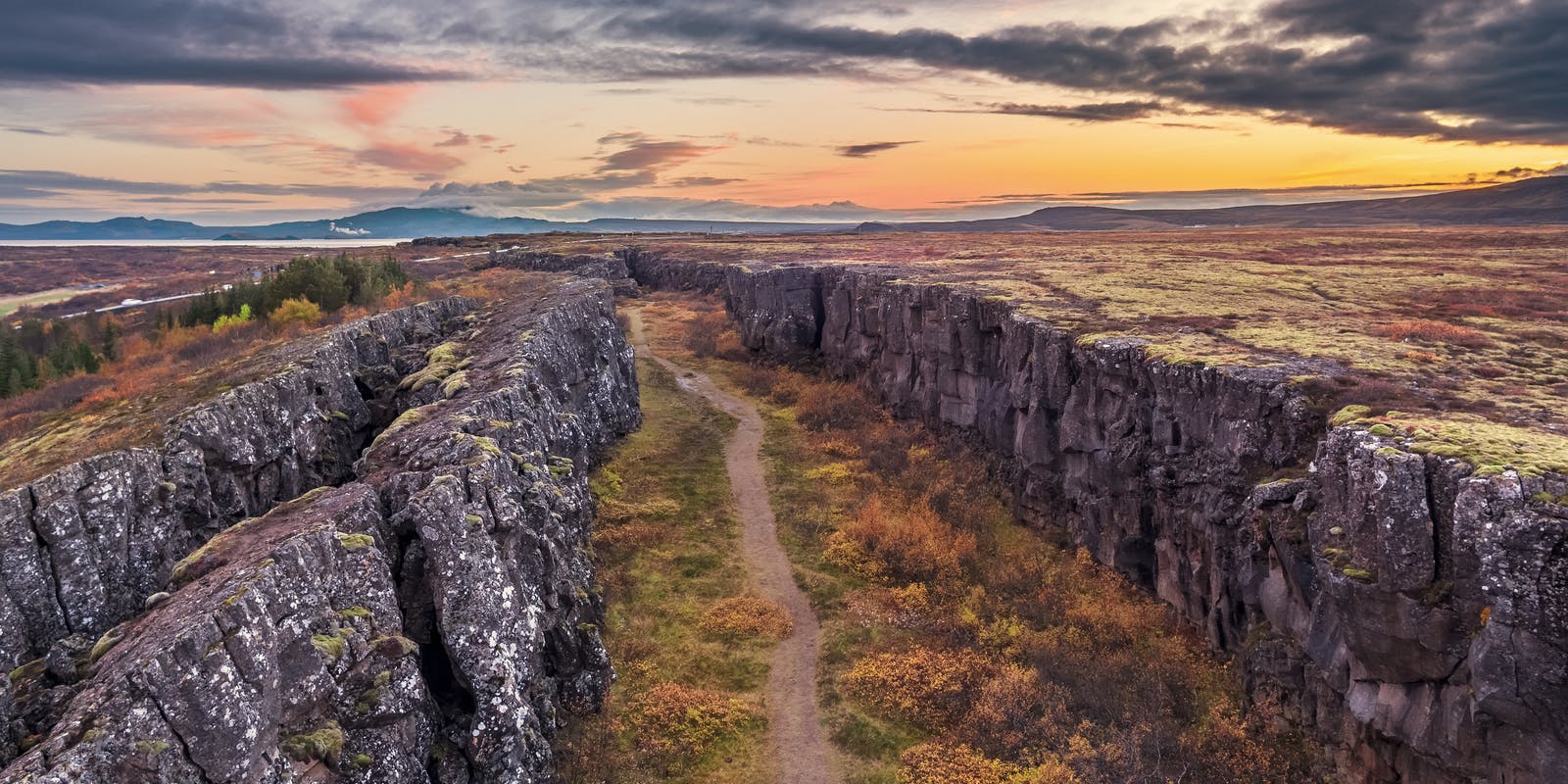
Experience the Tectonic Plates in Iceland
Iceland is located on the Mid-Atlantic Ridge, which is a boundary between the Eurasian and North American tectonic plates. As a result, the country is prone to volcanic activity, earthquakes, and geothermal activity.
Iceland is home to numerous volcanic systems, many of which have shown increased activity in recent years. Learn more about active volcanoes in Iceland and how they shape the country’s dynamic landscape.
Indeed, Iceland is a volcanic island constantly in flux, with magma breaking through fissures and periodic eruptions redesigning the rocky landscape. Iceland’s land is made up of igneous rock, most of which is basalt, which forms from cooling magma. Most of Iceland’s mountains were formed with basalt that has been carved by water and ice erosion.
What Is a Tectonic Plate?

The Earth’s inner structure consists of several layers: crust, solid upper mantle, viscous lower mantle, liquid outer core, and solid inner core. The upper mantle and the crust form the lithosphere, broken up into seven major “plates” and dozens of smaller plates called tectonic plates. Simply put, it is a gigantic slab of solid rock that moves separately from the other tectonic plates, interacting with them just along the boundaries. Therefore, the Eurasian and North American continents are embedded in the tectonic plates and slowly drift apart.
Where Can You See Tectonic Plates in Iceland?
South Iceland is where you can experience the tectonic plates on the island. Plan to visit the Reykjanes Peninsula and the Golden Circle region to view the meeting points of the North American and Eurasian tectonic plates.
Bridge Between the Continents

Travellers can visit a spot where the Mid-Atlantic Ridge crosses Iceland, the meeting point of the Eurasian and North American plates. The Bridge between Continents is a 50 ft footbridge in the Reykjanes Peninsula spanning a gaping rift between the Eurasian and North American tectonic plates. The small footbridge is a symbolic site connecting the two land masses, offering visitors an impressive view of the ridge. You can reach the bridge from Route 425, a 20-minute drive south of Reykjanesbær.
Þingvellir National Park

Þingvellir National Park is a UNESCO World Heritage Site, and the biggest part of it is the Mid-Atlantic Ridge in Iceland. The park is technically getting larger every year since the North American and Eurasian plates are pulling the country apart by a few centimetres every year. The park’s stony, moss-covered landscape is home to Almannagjá (All Man’s Gorge), which is the tallest cliff face in the national park and the original backdrop to Iceland’s first parliament. This rock structure is considered the edge of the North American plate, which visitors can view up close. Across the gorge visitors can see the Europian Plate. It’s an impressive sight, so be sure your camera is ready.
Silfra Fissure
It’s possible to dive into the Silfra fissure in Þingvellir and see the tectonic plates underwater. Filled with fresh spring water, it’s a popular site for diving and snorkelling tours. The crystal-clear water reveals an underwater world with jagged canyon walls, plant life, and fish. The fissure is said to have opened in 1789 due to moving tectonic plates. The water in it never freezes, keeping a constant temperature of 2-3°C (35-37°F). Fresh water constantly enters the fissure, so it never settles to freeze.
Are Volcanoes Related to the Tectonic Plates in Iceland?

Iceland is situated on two major tectonic plates that are moving apart, and when tectonic plates are moving apart, magma is released from the Earth’s mantle creating fissures in the crust. The fissures act as a channels for magma to continue to emerge on this particular spot, creating volcanos.
Since the continental plates continue to drift apart in Iceland, magma continues to find its way to the surface, keeping many of Iceland’s volcanoes active.
Is It Safe To Visit the Mid-Atlantic Ridge?
Yes, tens of thousands of travellers visit the mid-Atlantic ridge site in Þingvellir National Park and the Bridge Between Continents in
the Reykjanes Peninsula. There is no immediate danger. To dive in the Silfra Fissure, you must sign up for a diving or snorkelling tour.
Learn About Iceland’s Geology in Reykjavík

Perlan’s Forces of Nature exhibition in Reykjavík is a great way to learn about the island’s unique geology. For instance, interactive displays feature information on the power of volcanoes and earthquakes and the renewable geothermal energy that lies below the surface of Iceland. Guests get to see, hear and feel the result of Earth’s weak points along fault lines where tectonic plates diverge, as in Iceland’s case
Iceland's Tectonic Plates FAQ
Can you walk between two tectonic plates in Iceland?
Yes, you can walk over the Bridge Between Continents in the Reykjanes Peninsula and take a diving tour between the plates at the Silfra Fissure in Þingvellir National Park.
Can you touch tectonic plates in Iceland?
You can touch the tectonic plates in Þingvellir National Park and take a ceremonial walk over the Bridge Between Continents in the Reykjanes Peninsula.
Is Iceland being torn in two?
The North American and Eurasian tectonic plates are slowly moving apart at a rate of a few centimetres per year. The gap is constantly filled by new magma coming from the Earth’s interior. Therefore Iceland is not splitting up into two islands.
How fast are the tectonic plates moving in Iceland?
It is happening very slowly; in Iceland, the North American and Eurasian tectonic plates are moving apart at a rate of about two centimetres per year.
Can I learn about Iceland’s geology in Reykjavík?
Yes, Perlan’s Forces of Nature exhibition covers the tectonic plates, volcanoes, earthquakes and geothermal energy of Iceland.







